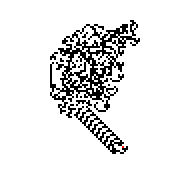 W
WA Turing machine is a mathematical model of computation that defines an abstract machine, which manipulates symbols on a strip of tape according to a table of rules. Despite the model's simplicity, given any computer algorithm, a Turing machine capable of simulating that algorithm's logic can be constructed.
 W
WThe Emperor's New Mind: Concerning Computers, Minds and The Laws of Physics is a 1989 book by the mathematical physicist Sir Roger Penrose.
 W
WLangton's ant is a two-dimensional universal Turing machine with a very simple set of rules but complex emergent behavior. It was invented by Chris Langton in 1986 and runs on a square lattice of black and white cells. The universality of Langton's ant was proven in 2000. The idea has been generalized in several different ways, such as turmites which add more colors and more states.
 W
WShadows of the Mind: A Search for the Missing Science of Consciousness is a 1994 book by mathematical physicist Roger Penrose that serves as a followup to his 1989 book The Emperor's New Mind: Concerning Computers, Minds and The Laws of Physics.
 W
WThe following article is a supplement to the article Turing machine.
 W
WA Turing machine is a mathematical model of computation that defines an abstract machine, which manipulates symbols on a strip of tape according to a table of rules. Despite the model's simplicity, given any computer algorithm, a Turing machine capable of simulating that algorithm's logic can be constructed.
 W
WIn theoretical network science, the Turing switch is a logical construction modeling the operation of the network switch, just as in theoretical computer science a Turing machine models the operation of a computer. Both are named in honor of the English logician Alan Turing, although the research in Turing switches is not based on Turing's research. Some introductory research on the Turing switch was started at the University of Cambridge by Jon Crowcroft.
 W
WIn computer science, a turmite is a Turing machine which has an orientation as well as a current state and a "tape" that consists of an infinite two-dimensional grid of cells. The terms ant and vant are also used. Langton's ant is a well-known type of turmite defined on the cells of a square grid. Paterson's worms are a type of turmite defined on the edges of an isometric grid.